Read How the Old Masters Saw the Stars first for a primer on celestial metaphor
This essay is based on a script that I wrote nearly a year ago to accompany a slide show, so there are quite a few pictures, enjoy!
One of the things that really stuck out to me when I started to seriously study tarot was that Pamela Colman-Smith had painted The Fool posed like the constellation Orion with the dog behind him perfectly mimicking Canis Major, The Empress was a Virgo figure, The Hanged Man was posed like Perseus and the Star card featured Aquarius. What else could she have been possibly hiding?
While I have been able to find some blogs and forum posts online that acknowledge this, thus far no book I have read has mentioned it. This includes Oswald Wirth who has a full astronomical system where each of the Major Arcana gets it’s own constellation. In Wirth’s system the Hanged Man is indeed Perseus and the Empress is Virgo, but he assigned Pisces to the Star. The Fool can’t be Orion in Wirth’s system as that slot is taken by the Magician. This was done to match up with the old Levi Hebrew correspondence of Aleph. In this system the Magician is also Taurus, Orion and Taurus at the same time as Orion fights the Bull. The logic here is that the oldest Hebrew rendering of Aleph resembles a bull. Wirth also noted that the way the Magician was posed somewhat resembled a modern Aleph.1

To Wirth, the Fool was Cepheus2, a grouping of stars in the deep northern sky. Stars in that region remain out all year regardless of seasons and held special significance to the Ancient Egyptians. This lends this interpretation merit as we are never without folly.
Modern systems have thrown out the old nineteenth century interpretation and associated the Fool with Aleph. He definitely shares more points of identity with Orion given his more consistent pose, the dog attacking his leg and exposed genitalia. Orion also wanders through the sky for half of the year until he eventually ‘falls off a cliff’ and sinks below the horizon.

I noted in a previous post that I think this Fool is Orion tradition goes all the way back to Bembo and likely before. Note the comparison above, while Bembo’s fool lacks the outstretched hand it does line up with nearly every other point of identity. Given the stars prominence in the sky, Orion was important to many cultures and often associated with one of their central gods as the constellation’s return meant the rainy season. The nearby Hyades in Taurus has a similar association.

In the ancient Egyptian religion Sah was the personification of the stars of Orion and Lepus was his boat, this constellation became important because it rose directly before Sirius of Sah's consort Sopdet known to the Greeks as Sothis, the brightest fixed star which was important to calculating the Egyptian Calendar, these stars later came to be associated with the much more famous Osiris and Isis
Sah is referred to as the Father of the Gods throughout the Old Pyramid Texts and the pharaohs were thought to travel to Orion after their deaths.3 The Orion Nebula is the birthplace of stars, it is essentially a cosmic nursery and it’s located about where you would expect given the depiction of Orion figures. While it’s mind boggling to think the ancients may have known about Orion’s Nebula, this seeming correlation is more than likely the result of coincidence.
In the Kabalistic interpretation of Tarot, The Fool is the cosmic god man from whence all things came4, basically Sah.

Orion held a deep significance to the ancient pastoral tribes of the near east given the constellation’s status as a rainmaker. In the Epic of Gilgamesh the goddess Ishtar (Innana in older versions) unleashed the Bull of Heaven to crush Gilgamesh after he had spurned her advances.5


There is another famous Sumerian king who is associated with the constellation, Nimrod, whom Genesis 10:9 describes as ‘a mighty hunter before the Lord’. This is sometimes interpreted to refer to the ancient king’s pride in defiance of God and thus the name Nimrod is synonymous for Fool.
The Old Testament uses the word Kesil in reference to the constellation Orion and in other contexts uses it to mean fool. Kesil is used to mean Orion in Job 9:9 and Amos 5:8 in the King James Version, but that was added in the translation as it only appears in Job 38:31 (above) in the Septuagint.
Could this have been what the tarot artists were playing on?

The Sumerian deity Dumuzid was known as ‘The God of Milk and Shepherds.’6 The Constellation Orion stands right next to the Milky Way in the sky and is surrounded by various animals, however in this tradition instead of being his game they are his flock. The arm of Orion inside the Milky Way can be seen as a shepherd’s crook.
Aries the Ram is one of those constellation whose outline doesn’t quite resemble what is purported to. While H.A. Rey’s revision works decently enough, I hypothesize that the tradition of Aries the Ram originated through the greater context of Orion the Great Shepherd.
In addition to being a patron of shepherds, Dumuzid was a god of fertility. He was a dying and rising god associated with the spring rains and was thought to have perished during the dry heat of summer. In ancient Lagash, the sixth month of the year was known as Dumuzid and people all across Sumer would mourn over his death.
Tammuz was the later western Semitic understanding of the same diety. He was widely worshiped all across the Mesopotamia, but especially in Syrian and Palestine. The consort of the Goddess Ishtar, Tammuz was mauled to death by a wild boar while tending his flock. Distraught, his wife journeyed into the underworld to retrieve him. Tammuz’s death was thought to have brought the long dry season which ended upon his triumphant return each year. The fourth month of the Babylonian, and the later Jewish calendar, the equivalent of June-July in our modern calendar, was named Tammuz. Ezekiel 8:14 speaks of women mourning for Tammuz.7
The Ugaritic texts speak of a hero named Aqhat who possessed a divinely crafted bow. After refusing various offers for his bow from the Goddess Anat - including some of an implied sexual nature - the frustrated goddess sent one of her devotees in the form of an eagle to assassinate the hero. After his death there is a drought and the crops fail.8
In the classical Greek myths, Adonis was the most beautiful man alive and lover to both Aphrodite and Persephone. One day Adonis was out hunting and he was mauled to death by the boar of winter - who I speculate may have been a proto constellation made up of the stars of Scorpio, Libra and perhaps others - but that is one for another day. There are various versions of who sent the Boar, some say it was Ares, in other tellings it’s Artemis or Apollo. The 7th century BC poet Sapphos tells of the women of Lesbos celebrating festival of Adonia every year at midsummer.9
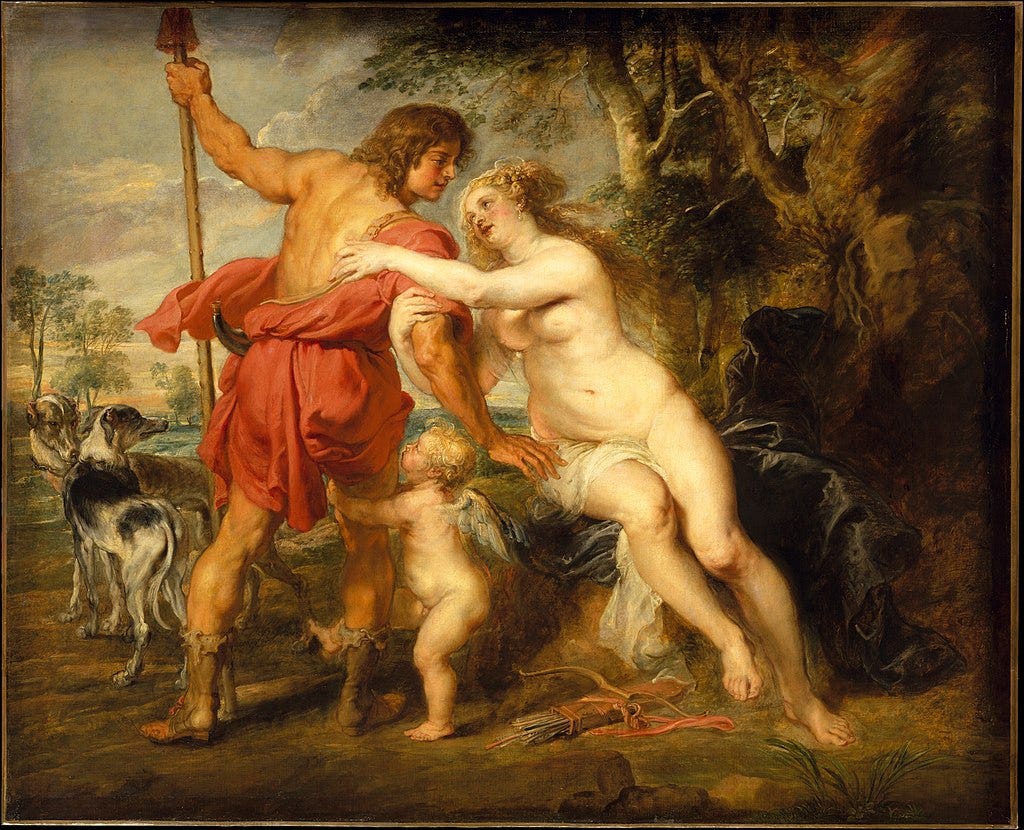
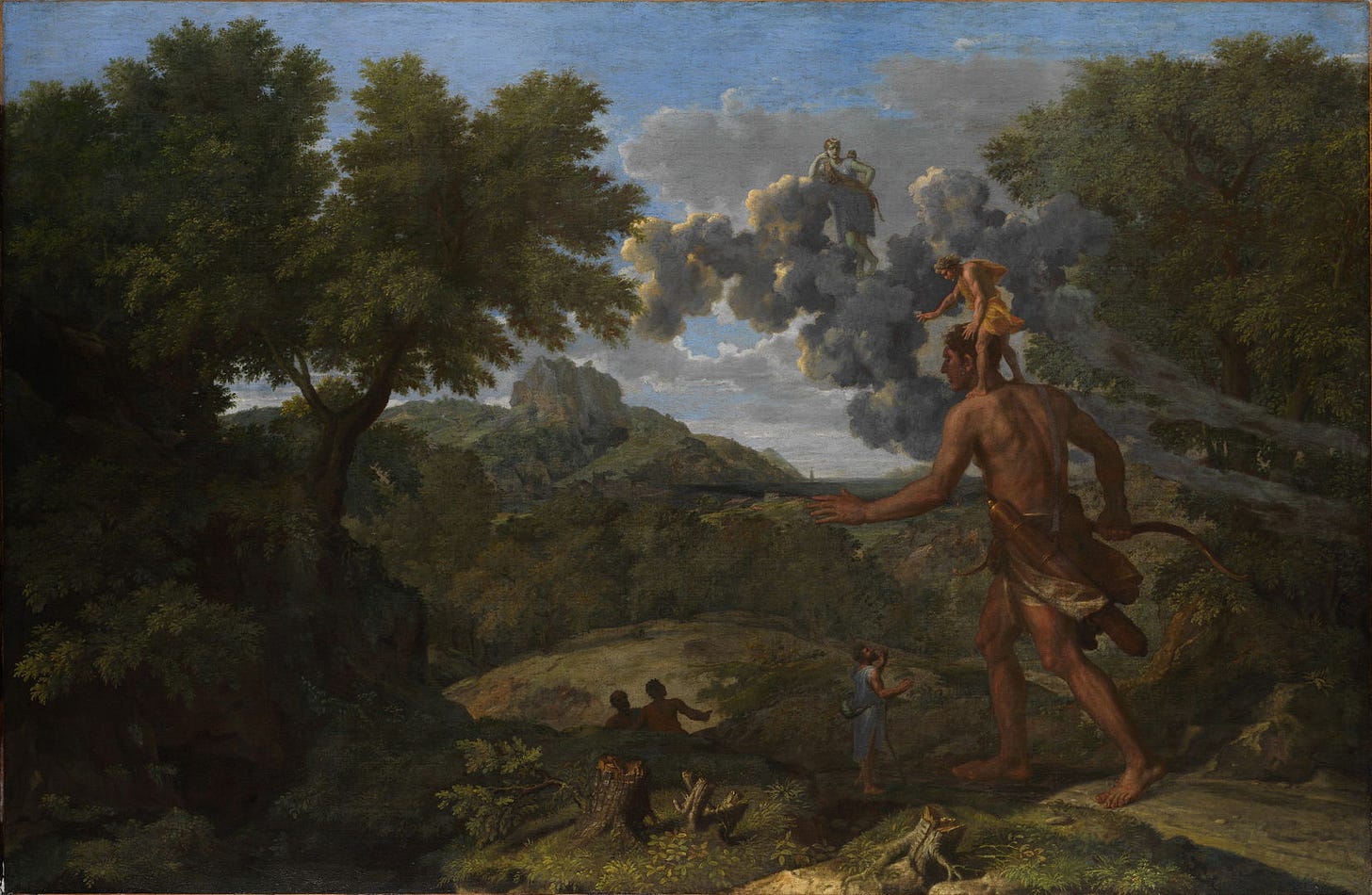
What of the Original Greek Legend from which the constellation was named? The Orion legend is most ancient as Homer talks about the great hunter Orion when Odysseus sees him in the underworld. Hesiod wrote a big book of star myths called the Astronomia but unfortunately it was lost, then Eratosthenes wrote his own star myth book that heavily referenced it called the Catasterismi but that too was lost. All we have left of it is known as the Epitome Catasterismi by Pseudo Eratostohenes, a second hand summary of what Hesiod may have said.10
According to the Epitome, Orion was the son of Eurayle, the daughter of Minos, and of Poseidon and thus as the son of the sea king he could walk on water so he walked across the water to the island of Chios.
On Chios Orion got drunk and violated Merope the daughter of Onepion. This understandably angered Onepion greatly so he blinded Orion and kicked him off of his Island. There are traditions that expand on Dionysus's influence in this part giving him a more active role both in getting Orion drunk to begin with and then later sending his Satyrs to drug Orion so that Dionysus's son, Oenopion , may have his revenge. At any rate, banished from Chios Orion wandered on to Lemnos where he met Hephastesus.
Hephaestus took pity on Orion and gave him a servant named Cedalion to stand on his shoulder and guide him east where he met Helius who cured his blindness. Once healed, Orion went back to seek vengeance on Oenopion but he was "hidden by the townspeople beneath the earth" Orion then gave up and went to Crete.
On Crete Orion hunted wild game in the company of Artemis and Leto and everything was going great until he boasted that he would slay every beast on earth. This upset Gaea, the earth itself, who sent a giant scorpion to destroy Orion. There are other versions of his death. In one of them, Apollo doesn’t like Orion hanging out with his sister, Artemis, so he tricks her into shooting a distant object at sea—which turns out to be Orion going for a swim. He then drowns.
After Orion's death, Artemis and Leto petitioned Zeus to put them both in the sky to commemorate this event and indeed as one sets the other rises, Orion is absent from the summer skies from May-July in the Northern Hemisphere.

There are other legends of Orion, for instance Ovid gives us an alternate account of his birth in the Fasti where Zeus, Hermes and Poseidon have dinner with a farmer named Hyrieus and for his hospitality grant him a wish. He wishes for a son and they oblidge but first he must perfrom a water making ritual with an ox skin that Ovid was ashamed to describe, then bury said ox skin and wait 10 months. Then from the earth Orion was born which Hyrieus 'named Urion for his conception' - one of those words whose name gets butchered badly in modern English like Uranus, Ourranus.11 The name Orion means 'Light of Heaven', probably derived from the Sumerian Uru-an-na meaning roughly the same thing - thus the constellation’s close resemblance to Gilgamesh (Ori - ‘Light’ in modern Hebrew, Anu - ‘Sky’ in various languages including Sumerian). Scorpio has the exaltation of Uranus in modern astrology and Uranus is the corresponding planet to the Fool in modern tarot systems.

The Epitome’s version of the Orion legend had 4 essential beats:
Orion ventures to Chios to hunt, on Chios he upsets Oenopion who blinds him.
He then goes seeking a cure from the rising sun, ends up in Lemnos where he is healed.
Returns to Chios seeking vengeance but can’t find Oenopion because he went underground.
Gives up and goes hunting with Artemis on Crete which leads to his demise from the Scorpion.
Compare these beats with the Constellation’s behavior in the sky:


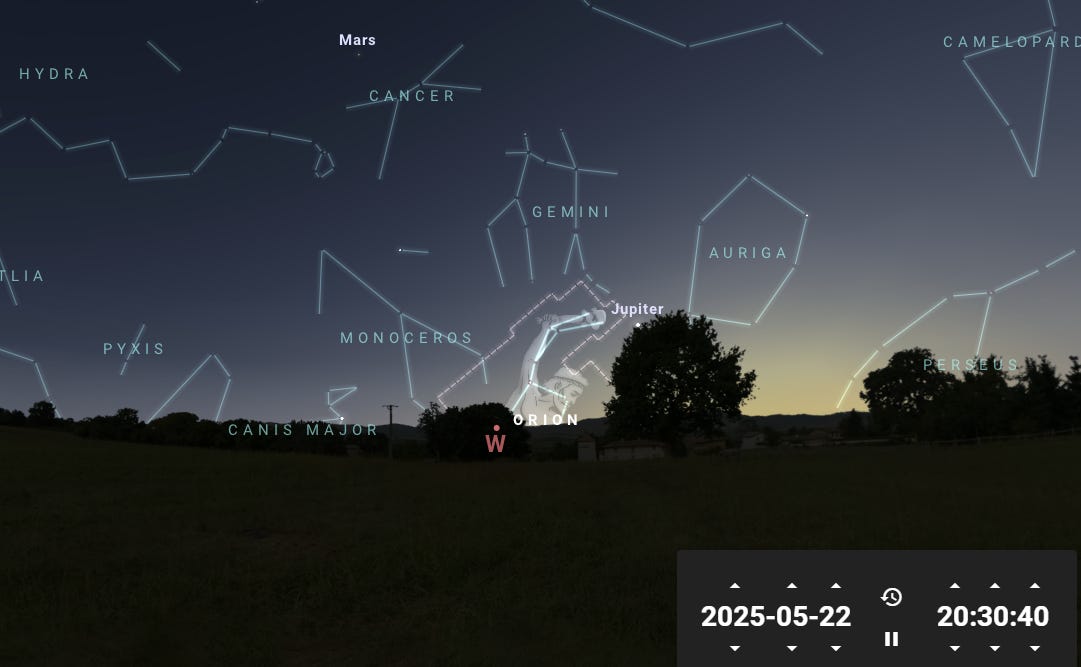

The authors of Hamlet’s Mill thought the biblical Samson was Orion12, and perhaps so did Guido Reni, there certainly is an argument for it
Samson shows up and slays a Lion, perhaps a metaphor for Orion’s return in the late summer. He then grabs the jawbone, in this interpretation, the Hyades of Taurus. He uses this unconventional weapon to slay his enemies. Samson also chases after women just like Orion does. And the women he desires aren’t the ones from his tribe, he chases after the women from the other constellation, the seven sisters of the Pleiades.
As the story goes, Samson's parents took a vow to never cut his hair but eventually Samson hooks up with a woman named Delilah who convinces him to cut his hair. Thus by breaking his scared vow, Samson loses his godly strength.
In Arabic the stars of Orion are known as al-Jawza or the Lady in the Middle, a complex that began with the belt but grew to encompass that entire region of space, the stars that normally make up the lion skin or the shield/bow are in this case the flowing locks of hair which is the part of Orion that sets first.13 The bow in this analogy is on the opposite side as other examples. It could also be said ‘with his hair gone Samson-Orion continued to fight on with his one good arm.’
The traditional name Betelgeuse was derived from the Arabic يد الجوزاء Yad al-Jawzā’ "The Hand of al-Jawzā’
Meissa "Shining One".
Bellatrix – The Female Warrior
Saiph – Sword of the Giant
Rigel – Rijl al-Jawzah, “Leg of al-Jawzā”
*Belt Stars*
Altinak- 'The Girdle'
Alnamim – derived from al-Nitham 'The String of Pearls'
Mintaka – 'The Line'Samson’s story begins in Judges 13: 3-5 when he the angel of lord appears to Samson’s parents telling them they shall have a son who will be a hero to their people but he must observe strict religious customs such as not drinking alcohol, eating any ‘unclean thing’ or cutting his hair. Samson’s story then unfolds across the next 3 chapters and has 4 essential beats following a similar pattern as the Orion legend.
First Samson goes hunting, but not animals he chases after women Judges 14:1-2, though in verses 5-8 he does slay a lion.
An incident occurs in Judges 14: 18-19 when Samson gets into a violent altercation with the neighboring tribe. On a quest for vengeance, he does a bunch of crazy stuff like tying 300 foxes together by their tails and setting them on fire (Judges 15:4). In verse 15 he takes the jawbone of an ass and slays a thousand men.
Samson seems to forget revenge for a while when he meets Delilah at the beginning of the next chapter (Judges 16: 1-4). The honeymoon continues until Judges 16: 19 when Delilah convinces Samson to cut his hair thus breaking the pact his parents made with God when he was born.
After Samson cuts his hair, his sacred pact is then broken and he begins loses his strength, setting in motion the events of his demise. Captured by his enemies but defiant to the end, with his last remaining strength Samson pulls down the pillars of the temple taking everyone with him as he goes (Judges 16: 27- 30).
(This scene, as well as the lion slaying, inform the art found on some of the Strength/Fortitude Tarots.)
An alternative theory is that Samson is a solar hero. The name Samson means ‘Sun Child’ or ‘Little Sun’ in hero. His 7 locks of hair could be referring to the beams of the sun’s crown often depicted in ancient art symbolizing the 7 months of the sun’s ascension in the sky.14 Delilah whose name means the ‘good night’ or possibly ‘goddess of night’ could be seen as a Lunar figure, possibly an analog for Artemis who lead to Orion’s demise in his own legend. In either case , the details of Samson’s story are so wild that a stellar interpretation makes less assumptions than if we were to take the story literally.
As it is such a prominent grouping of stars there are many more analogs of Orion. The Norse had Baldr the Beautiful, the beloved son of Odin, of which Loki tricked Höðr into slaying with a Mistletoe arrow.15 In another Norse legend, perhaps another son of Odin, Thor, was portrayed by Orion.
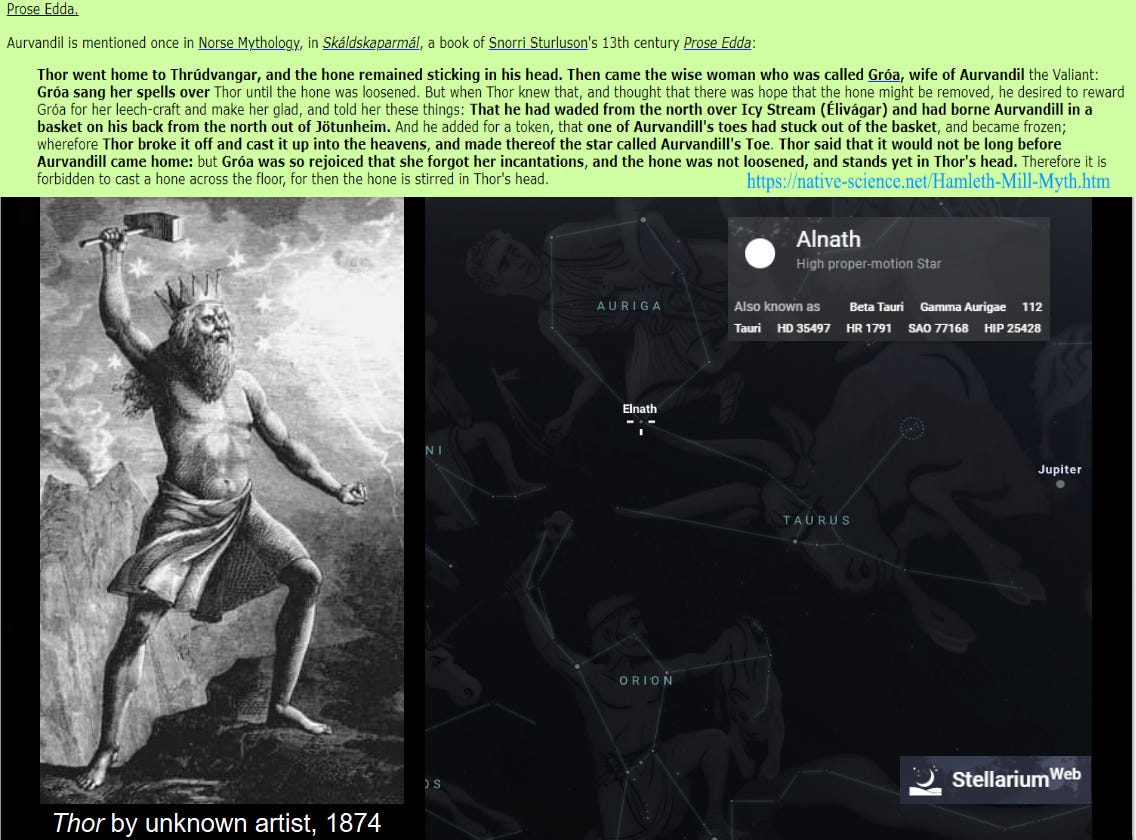


There was a Roman rustic deity, god of the forest and wild places known as Silvanus. In addition to his role as a fertility god he watched over the flocks and fields. He is usually depicted accompanied by a dog, carrying a falx in one hand and a tree branch in the other. He dresses in a simple peasant’s tunic if he bothers to even wear clothes at all.16 As what we have moved further west, what the stellar cultists in the desert saw as a shepherd has now become this wild man of the forest.
A dying and rising god of nature, Dionysus is one of the most ancient of gods. Though Silvanus and Dionysus are not directly related to each other, they both share an association with Pan. As he was syncretized with Osiris in Hellenic times so perhaps Dionysus can also be associated with Orion, though his festivals don’t seem to line up as well with the cycles of the stars as the other gods in this list. He is often depicted riding around on a tiger which could be a reference to Orion’s return in the late summer. Many Virgo figures are also depicted in this way, the tarot strength card is an easy example of this.
It has been proposed by multiple authors that Dionysus is related to the the Tarot Fool. In his 1971 book, Paul Huson described the metaphor of the tarot sequence as telling the story of the life of Dionysus.17 Considering he learned to read tarot from Dion Fortune and studied under Israel Regardie, this very well may have been the Golden Dawn’s legitimate teaching. Consider Waite’s divinatory meanings for the fool: folly, mania, extravagance, intoxication, delirium, frenzy, bewrayment. Though Waite never said anything about the fool being Orion and neither did Paul Huson, though I would imagine that Colman-Smith knew what she was painting.

Tarot historian Michael Howard has authored at least 2 lengthy articles arguing that the Fool is Dionysus, though he doesn’t bring up Orion as far as I have read.18 He begins the more recent of these articles arguing in favor of a hypothesis originally proposed by Andrea Vitali that the word ‘tarocchi’ derives from a classical Greek source about an adherent of Bacchus named ‘Tharopes’ or possibly ‘Tharocus’. In the second part of this essay he goes on to argue that this word became Italianized and derivations of it begin popping up in works from around the end of the XV century used in context to mean roughly fool or madman. '
Some of the earliest examples of these derivations in use come from works written in the Macaronic verse such as Giovan Giorgio Alione - taroch in (possibly) 1494 (to refer to a game) and Bassano Mantova - tarocchus in 1499. I discussed many of these points in the first full essay that I ever posted on this blog which you read here. What is most important to the discussion at hand is the Macaronic Language which has been described as a Neo-Latin, itself part of this hip trend to combine languages for poetic effect. In these verses we find Latin, Italian, local dialects and various other languages such as German and Greek all mish mashed together in a fascinating blend few can understand today. It may seem like a longshot to get the Fool to Orion through some Dionysus worshipping madman known as the Tharocus who lives in the woods with his dog and brandishes a pinecone staff but it is this through this wordplay that such a thing becomes plausible


In Latin Follies means roughly a bag of wind or a bellows, something that is full of hot air or an airhead.19 Wordplay and puns, like we find in the Marcaronic verse, has long been a staple of allegorical figures. Above are two statues from Ferrara Cathedral of two figures representing the astrological decades of April and March respectively. The figure of March is depicted as a Fool blowing a horn while the figure of April is wearing a floral crown.
March has long been associated with strong winds. In Botticelli’s Primavera (below) the Dark figure on the far right is Zephyrus ‘the biting wind of March’ who is shown kidnapping the nymph Chloris who he marries and transforms into the goddess of the Spring20 (I thought this was Hades and Persephone at first, but it is close enough).
March is also associated with the madness from the behavior of animals (mating season), there is an idiom about this that is at least as old as the Renaissance: ‘Mad as a March Hare. Remember how Orion was associated with bringing the spring rains, could he have been responsible for the March winds as well?

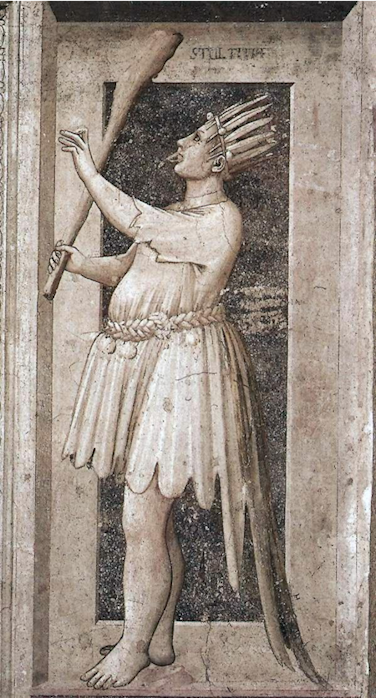
Gertrude Moakley suggested that the Fool was an Allegory of Lent and the feathers in the hair of Bembo’s Fool (below) represented the weekends during Lent. In her view, the tarot cards were a metaphor for a triumphal procession for Carnival - the last hurrah of the holiday season before the austerity of penitence of Lent. Though Bembo’s Fool more than likely took it’s direction from Giotto’s Stultitia(above) which is from the Latin for Stupidity or Lack of Reason - the opposite of Prudence whom this allegory was paired with. Moakley could still have been partially correct that Bembo was trying to capture some of the Carnival spirit in his Fool as the Carnival is, after all, a time of madness during March. Giotto’s Folly harkens back to another medieval holiday tradition, The Feast of Fools, where the Lord of Misrule is crowned with Feathers and playing at governance with his crude scepter. However there will be no sardonic quips from this Fool as his mouth has been clamped shut.

I stated in the beginning of this essay that I believe Bembo’s Fool may also be Orion though admittedly he is not waving like the other figures in this pose. Though he still retains the rest of the post and has implied frontal nudity. Perhaps he isn’t waving because this is a depiction of Orion in March, after that part of the constellation has set?
One of the points that Paul Huson used to tie the Fool to Dionysus in his book was the asshat he is depicted wearing in some the earliest tarot cards (above).21 There’s an interesting theory cited on The World of Playing Cards that the string of pearls on the Charles VI Fool is a reference to the Arabic name for Orion’s belt, Al Nitham - ‘the string of pearls’. The same page also suggests many of the cards in Charles VI, and perhaps other packs of noble tarocchi as well, contain celestial metaphors that only make sense in Arabic. The d’Este Fool (above, middle) is probably the most uncomfortable card in all of tarot but he is presented in the basic Orion stance waving a flag (or pinwheel) as well as other features that seemingly bothered someone else that it looks like they put a cigar out on this card. In both cases he is surrounded by what appears to be children but this could also be alluding to the fact that he is a giant. The Rosenwald card on the end is no true fool, but a juggler/magician wearing an asshat.

The asshat would evolve into the cap and bells medieval jesters were often depicted wearing. These hats maintained the symbolism of the ass with 2 dangling sleeves on the sides for ears and one in the middle, usually protruding forward, representing the tail. Another common feature of this design was the cockscomb design inspired from chicken. The pun here is still functional in our modern English as Fool is to Fowl.

Above is a compilation of watermarks resembling jesters take from Harold Bayley’s The Lost Language of Symbolism Vol. II (1912). In the excerpted text, Bayley suggests that a star was sometimes use to represent a Fool in watermarks with the association being the word aster, meaning star - like the shape of the fool’s cap, but also a pun on the word hysterical. Is the Fool depicted as a star-man because he is hysterical?
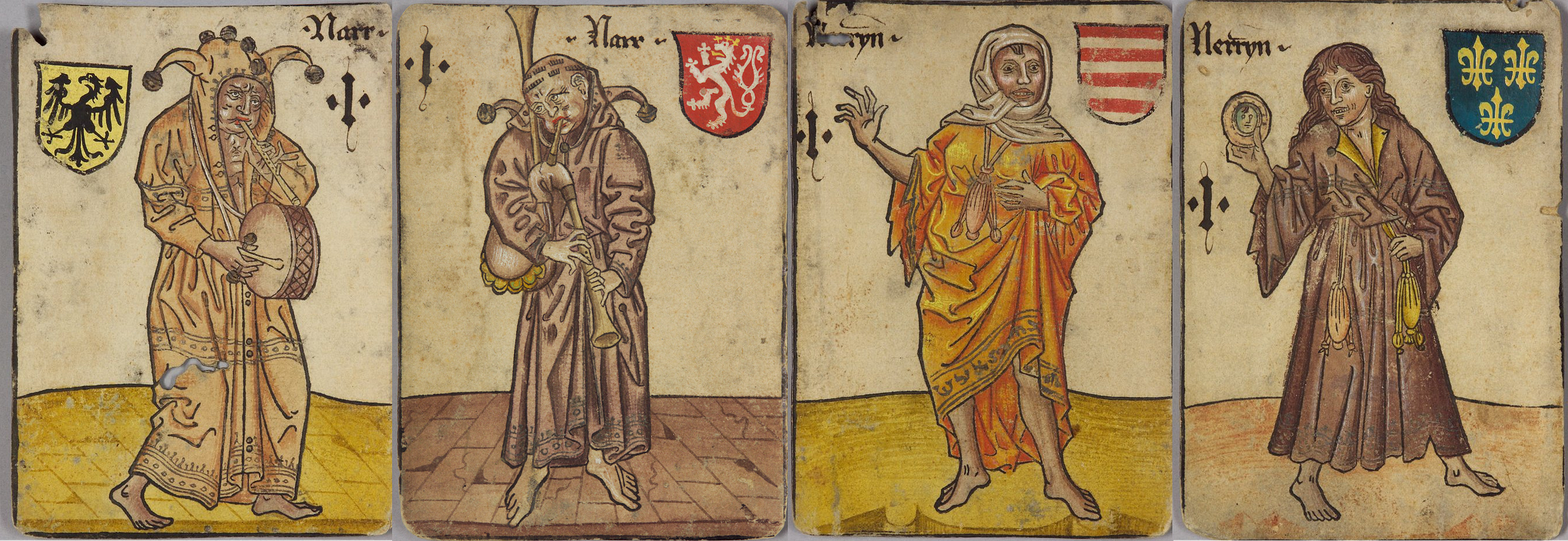
As Latin was the Lingua Franca of Europe during the middle Ages the fool puns present themselves in much the same way on these German cards above. The male fools are depicted playing wind instruments but the female fools are shown with small dangling bags of money playing on the Latin Follem for money bag. These designs were apparently known in Italy fairly early in the XV century as the Bolonais fool (Leftmost card below) playing the tabor and drum bears a strong resemblance to the Holy Roman fool (Leftmost above).
Southern style sampler. We have the aforementioned Bolonais Fool, though this is from a deck from 1650 the style that it presents was in use around the turn of the XVI century. Mitelli’s Fool is a merry man who could care less that he has lost his shoe, if he has even noticed at all. He has a feather in his cap and is carrying around a pinwheel with an air bladder tied to it. He greets us with his other hand. The Minchiate Fool harkens back to the d’Este Fool but now the madman has lost his, previously jovial, composure with the children who were teasing him.
The Mantegna fool could possible be a foil to my Orion theory as it may very well be this card that informs the biting dog on later cards and not an allegory for Canis Minor after all. He was depicted on this card as Misero an allegory for poverty and clearly not Orion. The Biting dog in this context was meant to emphasize his worthlessness. A similar design was adopted by Sicillian tarot (above right).

It was the Sola Busca Mato that originally convinced me I was on the right track with the Orion connection. The wind puns are present here again as he has feathers in his hair and he is playing the bagpipes. I took the knots on his waist rope hanging off to the side to be a play on the 3 bright stars of Orion’s belt. The knots could also be a reference to Ramon Llull as he was believed to have been the author of the Testamentum Theorica, an alchemical text that may have informed some of this deck’s symbolism. Llull belonged to the Franciscan order who have a tradition of tying 3 knots on their waist rope to symbolize poverty, chastity and obedience. The bird on his shoulder could be a reference to nigredo the first step in the alchemy process often symbolized by a black bird. Or Mithraic initiation. Or it could be a reference to St. Francis who was fond of birds. Oh Sola Busca your mysteries never seem to end.
The Leber Rouen deck is another non-standard deck similar to Sola Busca. In his Dionysus/Tharopes essay, Michael Howard cited some interesting commentary regarding its’ fool card:
“As Ross G .R. Caldwell and M. J. Hurst have explained, he has all kinds of weapons with him, but nothing for combating the insects buzzing around him (see http://pre-gebelin.blogspot.com/2009/04/witless-warrior.html). The motto, Ross says, is "I wish that a net would be given to me." He is a clear example of the angry but ridiculous madman. And not only are his genitals exposed, but he is urinating uncontrollably, as Hurst points out.”22

Puns abound in this Allegory of Folly from around the turn of the XVII century. He has the ears if an ass and his cockscomb is an actual cock’s comb. The airbladder on his fool’s bauble is instead a flatulent little man in pure ribald renaissance fashion.
The familiar fool of the Tarot de Marseilles wandering from town to town laden with bells, his air bladder has now evolved into a knapsack and the familiar dog is attacking his thigh.
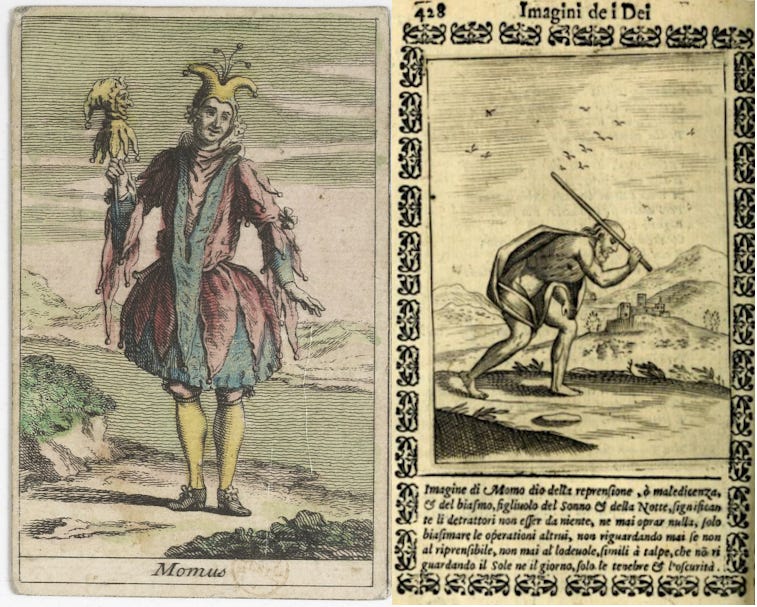
To bring yet another mythological figure into this discussion, Francois de Poilly depicted The Fool as Momus, the personification of satire and mockery, in his Minchiate deck. Like the fools in medieval courts, Momus was free to speak his mind and criticize the gods without fear of reprisal.
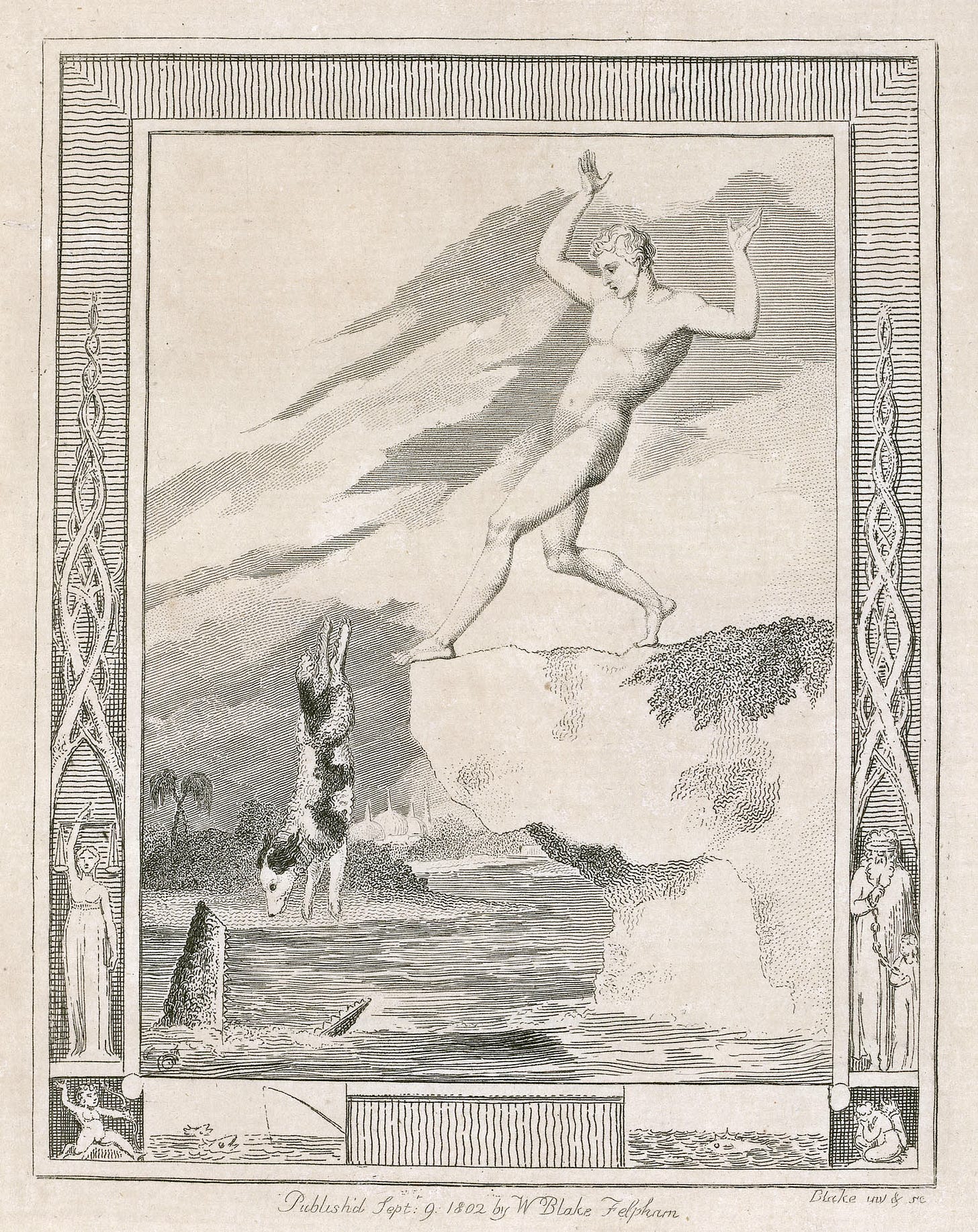
oldest discussion of the Fool’s Orion metaphor that I could find was in reference to debates regarding the William Blake Tarot back in the 90’s.23 This deck used the above picture as a basis for their Fool card, it certainly is curious as it would seem Blake could anticipate future trends. The cliff was an addition by Pamela Colman-Smith and the Crocodile doesn’t appear until the Egyptian tarots of the mid nineteenth century well after Blake’s time. Still Blake could have intended a celestial metaphor here, there is the River Eridanus near Orion’s feet with sea creatures such as Cetus lurking below. The astral symbolism seems a bit more clear in light of Albrecht Dürer’s star map (below).

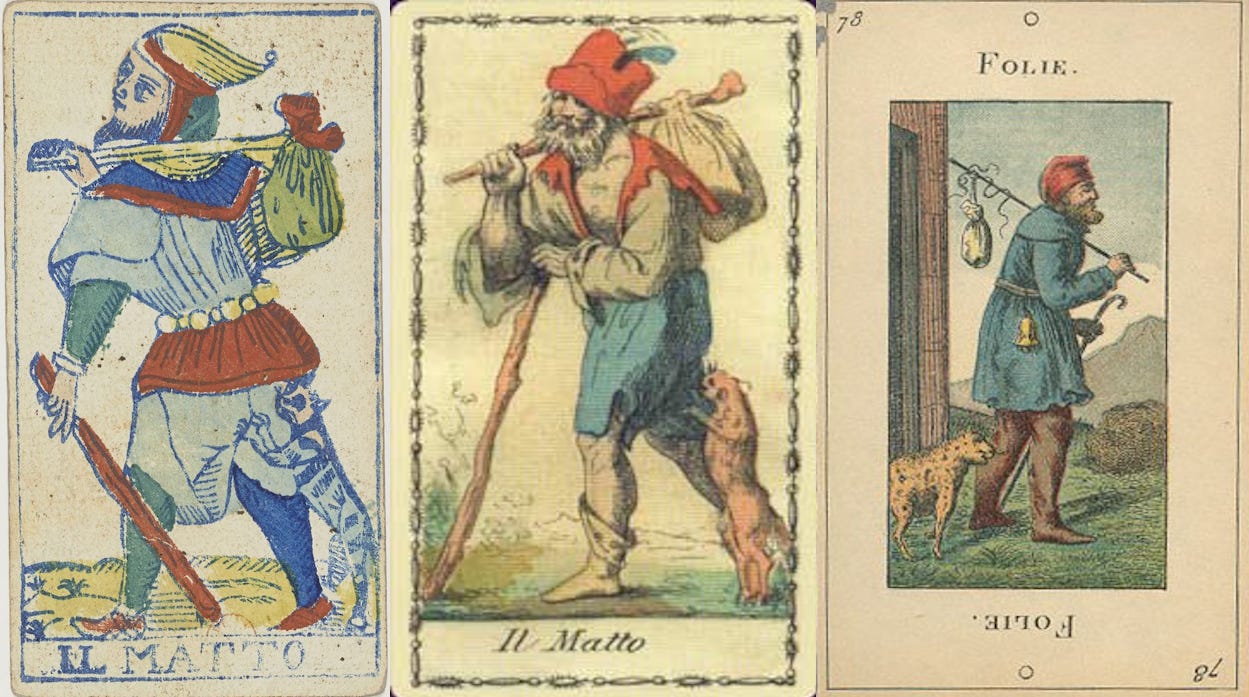
On these Fools the dog has now been replaced with a small feline, possibly a tiger. Is this perhaps a reference to Dionysus? And if so, could there possibly be more to the vine imagery found on the pip cards in many tarot decks including even the oldest noble tarocchi?
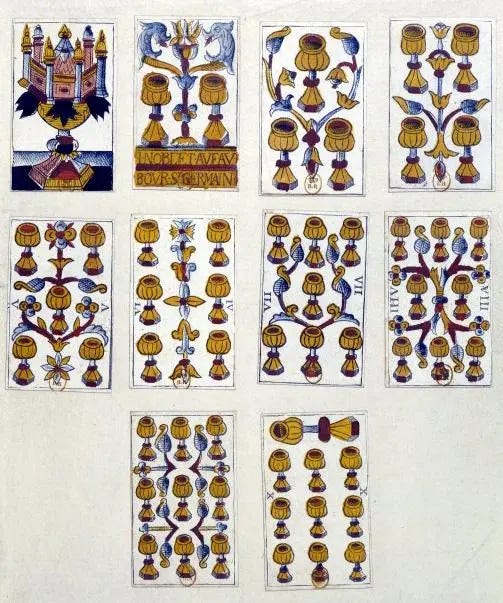
So now we have reached the end of our journey into foolish facts and have identified a few different reasons why the tarot artists might have painted the Fool to resemble the constellation Orion.
The first theory we discussed was Kesil meaning Fool in Hebrew and also being used to describe Orion. This is also related to the connection between Nimrod and Orion as he was described as a ‘mighty hunter before the lord’ - the sunrise in this context. This theory is possible but feels like a bit of a stretch. The next concept was that the Fool represents Dionysus, this theory has some support from tarot scholars but requires some assumptions to get to Orion. Then we had the connection with March, which I feel aligns better with Orion’s behavior. And lastly we discussed the fact that Fools were represented with stars on watermarks.
From all of that I surmise that at least some this is true - the fool is depicted in this way as he is the Mad Man of March for every reason we have discussed - the Carnival, the weather, the behavior of animals - and the pose is intended at least in part as a pun to emphasize hysteria.
So there you have it! Let me know in the comments if there is another reason why the fool is drawn this way, or if he is not Orion at all and I’m the real mad man for having written all of this. Thank you so much reading this far, if you enjoyed what I wrote please Like, Share & Subscribe as it really does help and I will see in the next exciting installment of INTO MYSTERY.
Ibid., [Pg. 155]
Theodore Roszak, Fool's Cycle/Full Cycle : Reflections on Great Trumps of Tarot (1988) [Pg. 11]
Star myths of the Greeks and Romans : a sourcebook containing the Constellations of Pseudo-Eratosthenes and the Poetic astronomy of Hyginus (1997) [Pg. 147-150] Archive
David W. Mathiesen, Starmythworld
Silvanus - Hellenic Faith
Paul Huson, The Devil’s Picturebook (1971) [Pg. 107]
Liber Theta [Pg. 13] Thelema.Org
Paul Huson, The Devil’s Picturebook (1971) [Pg. 112]
Michael Howard, Dionysus and the Historical Tarot: 15th-18th Century Cultural Contexts (2012)
I didn’t find the discussion itself, just an allusion to it, you can read the thread here: tarotforum.net/threads/the-fool-as-orion-split-from-greater-arcana-study-group-the-fool.250748/

















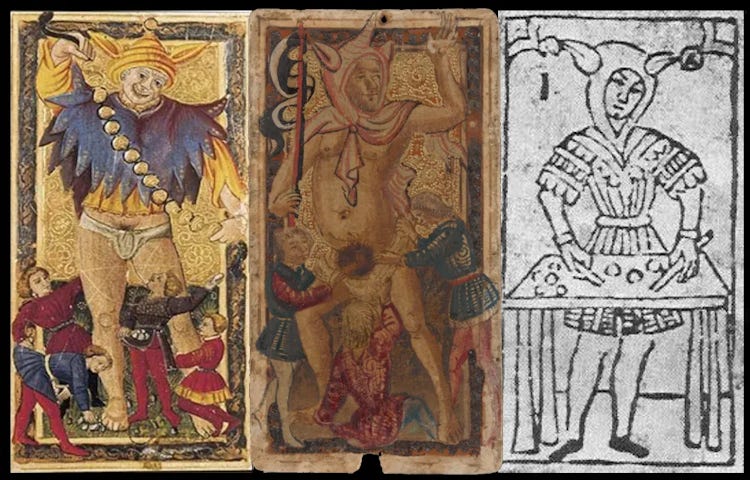

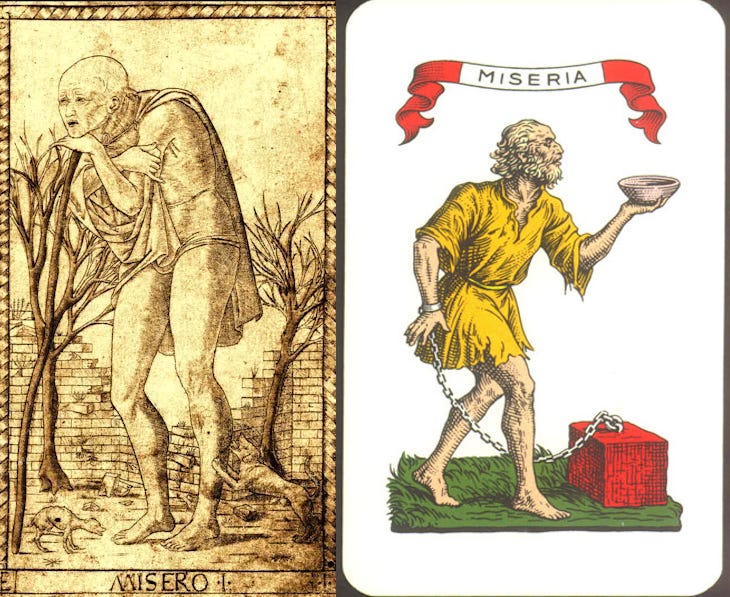


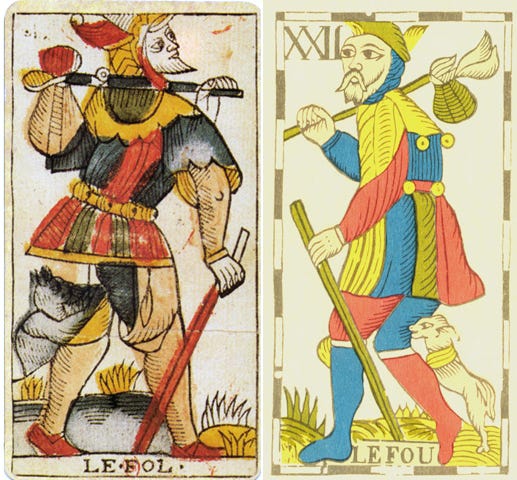



Love this one! Super fascinating. I wish we had the ability to see the stars like our ancestors did. I think artificial light at night is one of humanities biggest issues. I have to travel so far out to be connected to the constellations on this level, thanks for sharing! 🌌